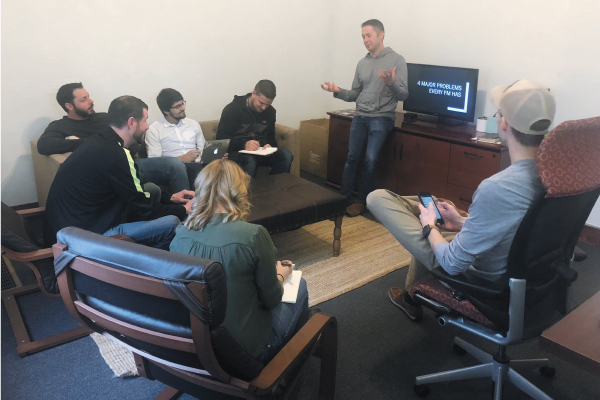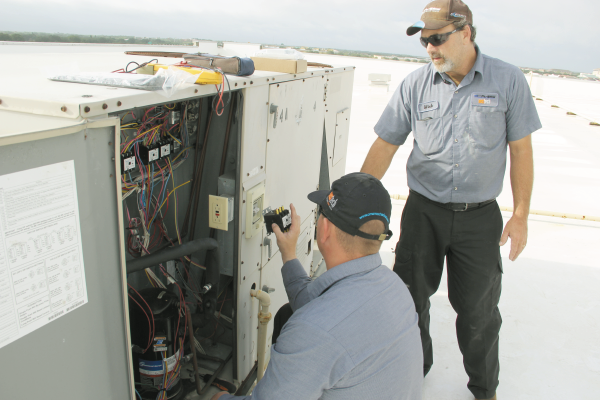Address technical and soft skills to create the most effective workforce.
Most people don’t start out planning a career in facilities management. They often come to it after working in a trade industry, starting out in a restaurant or retail facility, or even from other departments to take advantage of greater opportunities. For this reason, training employees to develop the varied skills needed in facilities management is a critical role for successful FM operations.
“The type of people in FM departments is very different today than years ago,” said Phil Donahue, Facilities Manager for Staples, Inc. “We used to hire people who retired from the trades, but it is more of a help desk environment today, which requires different skills.”
Differences in age also require a thoughtful approach to training, said David Magill, SVP of Program Management at Ferrandino & Son. “We don’t train people differently, but we know younger employees who may only have a few years’ experience are more fluent with technology and comfortable with communicating via email, and tenured employees are more comfortable with verbal communication.” The ideal training strategy is to combine the strengths of both groups, so each can handle electronic as well as verbal communication – and understand when each is required.
Staples’ FM department’s training program for new employees includes training on the work order system, and then on-the-job training with the support of designated veteran employees, explained Donahue. “Our people handle calls about everything from landscaping to HVAC issues, so it is difficult to develop a formal program to cover everything. New employees shadow an experienced employee while they learn the work order system, and then they partner with someone who can answer questions and provide guidance as they begin handling calls.”
Because everyone has different skills and different skills gaps, training is more personalized rather than prescriptive, Donahue said. “Some of our people have been here a long time and had to learn how to navigate Excel, while others picked up on it quickly,” he said. In-house software-based training programs and remote training via webinars are also available to employees who want to learn more about topics such as customer service tips, organization skills or communications strategies.
Not all training has to be formal, Donahue pointed out. “At monthly staff meetings, we discuss topics that help people improve the way they do their job, but we also discuss ‘aha’ moments to share stories about how we’ve diffused tension with an unhappy store manager, or solved a difficult problem,” he said. “Everyone handles so many different types of situations. This sharing helps the group learn how to handle something if they should encounter it.”
At Ferrandino & Son, training is a priority, as evidenced by the hiring of a full-time, in-house training manager three years ago. “The training manager provides ongoing training and education to all our employees as well as supplier employees,” Magill said. “Every new employee completes a two-week onboarding program during which they learn the work order system, company organization and communications strategies for customer service.”
There are also trade-specific breakout sessions led by in-house subject matter experts (SMEs). These in-house SMEs also serve as ongoing teachers and troubleshooters for the company, Magill said. “For example, our plumbing SME is a master plumber with more than 30 years of experience.” These SMEs not only share information during new employee sessions, but also consult with employees when they encounter unusual or difficult-to-solve problems.
New employees receive refresher courses throughout the year, and there are opportunities for management and product-specific training as well, Magill said. “We offer our training to vendors – onboarding to teach them the work order and reporting system and the invoice process.” The benefit of training vendors, especially customer-specific training for new vendors, is increased understanding of service expectations, scope of work and fewer issues throughout the relationship, he explained.
Strengthening
“soft skills” critical
While understanding the technical aspects of an FM position – work order system, supplier management program, basic knowledge about different trades – is important, the most difficult skills to develop in an employee are considered “soft skills.” The ability to communicate with customers, assume responsibility for getting the job done, juggle multiple tasks at one time, and effectively solve problems may come naturally to some people, but few excel in all areas without ongoing education.
Technical knowledge of different trades is not necessary, Scott Reyes, CEO of Envoy Facilities Management said. He typically hires former retail and restaurant employees who don’t understand how things get fixed, but they do understand the retail and restaurant business, so they understand how a non-working HVAC system or oven affects business.
Emotional intelligence is one of the most important skills needed in employees, Reyes said. “They need to be empathic and understand they are not here to fix things, but they are here to help people,” he explained. Ongoing education that helps employees learn how to express empathy and how to relate to customers as they help solve their problems is important, he added.
“Problem solving at all levels is also a critical skill,” Reyes said. “We teach employees how to actively listen to customers, how to use structured questions to get at the root of a problem, and how to evaluate options to address the issue.” With the fast pace of most FM departments or FM providers, the ability of every employee to make decisions and solve problems on their own ensures speedier resolution of customer problems, he pointed out. “If employees have to constantly bounce ideas off co-workers it takes longer to help customers.”
The FM of today and the future will also need to be a strong negotiator, Reyes said. “This isn’t about negotiating a contract. This is about the day-to-day negotiations that are part of our job.” For example, what tactics can be used to persuade the HVAC repair supplier to go to my customer’s site next? An FM employee who cannot negotiate and persuade is highly ineffective. Negotiation skills will increase in importance as the deficit in skilled labor continues to grow and FMs must compete for time and attention to their clients, he added.
Reyes’ company has invested in LinkedIn Learning as the foundation for ongoing employee education. “We have a series of courses all employees must take, but after those are completed, employees can take other courses that will help them develop skills for the job,” he explained. Envoy employees have 30 minutes every week during their workday to take a LinkedIn course. The ongoing, weekly expectation that employees will take time to focus on skill development creates a habit of ongoing learning, he added. “Employees can also access LinkedIn for courses not related to their jobs on their personal time.”
“We have had some people take video-editing and photography courses.”
Another creative way to promote learning and discussion of how to improve communications and relationships with customers and vendors, is the company book club. “We meet every Thursday for 30 minutes before work to talk about the book. We read one chapter each week,” Reyes explained. “We buy the book for everyone in the company, but participation in the Thursday meeting is voluntary. Participation is usually about 50 percent of the company.” Books read have included “Extreme Ownership: How U.S. Navy SEALs Lead and Win” and “Linchpin.” Topics include leadership, relationship building, perseverance, decision-making and problem-solving.
As technology increases in importance to the FM’s job, there will always be a need to offer robust training on systems, applications and devices used to improve the FM department’s ability to meet customer needs, but Reyes also pointed to the importance of training to retain FM employees of the future.
“We need to make sure our training programs develop the mental and emotional toughness FMs need today and in the future,” Reyes said. “Younger folks find it easy to give up and change jobs if the work is too stressful.” A focus on continuous learning helps employees handle tough situations, accept constructive feedback and develop professionally results in a more confident employee who is more likely to stay with the company, he said.
Be sure a training and education program results in employees taking action in their jobs – making decisions, finding solutions, seeking help when needed on technical issues but not overthinking things, Reyes suggested. Learning can be a form of procrastination as people try to learn everything they think they need to know before tackling the job, he said. Make it clear that everyone learns from “wins” and “mistakes.” He added, “Design a training program so that everyone knows: Here’s what we learned, now let’s apply these lessons.”
By: Sheryl S. Jackson





.jpg)





